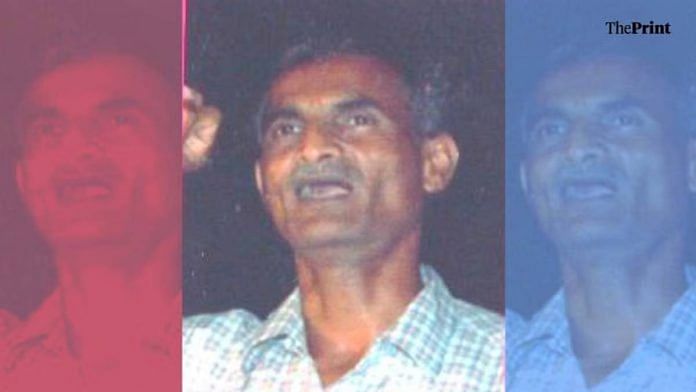New Delhi: The killing of 66-year-old Maoist leader Tentu Laxmi Narsimha Chalam, alias Goutham or Sudhakar, by security forces in Chhattisgarh’s Bijapur Thursday marks a significant moment in the chapter of the only—and unsuccessful—peace talks between the government and Maoists over 20 years ago.
On 11 October, 2004, Sudhakar had emerged with two other leaders of the banned Communist Party of India (Maoist), and two cadres of CPI (Marxist-Leninist)-Janashakti from the Nallamala forest, and addressed a public meeting at Guttikonda Bilam in then undivided Andhra Pradesh.
The two other leaders with Sudhakar were Akkiraju Hargopal, alias Ramakrishna alias RK, then state secretary of the CPI (Marxist-Leninist) People’s War, also known as People’s War Group (PWG), and Gajarla Ravi alias Ganesh, the then North Telangana special zonal committee member. The three went on to lead the peace talks with the Andhra Pradesh government.
The CPI (Maoist) was formed with the merger of PWG with the Maoist Communist Centre of India (MCCI) in September 2004.
After a few rounds of productive negotiations, the talks were called off by the Maoists in January 2005 on the grounds of continued operations by Andhra Pradesh’s Greyhounds force against the group.
The talks had been initiated after years of crackdown by the then N. Chandrababu Naidu-led government in Andhra Pradesh. Congress leader Y.S. Rajasekhara Reddy had promised the peace talks with Maoists if elected to power in the 2004 assembly elections. When he won, his government announced a ceasefire with the rebels in June 2004, initially for three months, and it was extended by another three months.
Starting 12 October, 2004, the Maoist leaders were accommodated at Manjeera guesthouse in Hyderabad, and the first phase of talks went on from 15 to 18 October at Dr Marri Channa Reddy Human Resource Development Institute. The trio of Ramakrishna, Sudhakar and Ganesh, representing the Maoists, was in attendance. The CPI (ML)-Janashakti, another Andhra-based armed rebel group of Maoists, was represented by leaders Amar and Riyaz.
During the 4-day talks, the state government and Maoist leaders held discussions on issues such as laying down of arms by the rebels, continuance of ceasefire as long as talks continued, distribution of surplus lands, release of political prisoners, withdrawal of cases against people involved in the revolutionary movement, ending of cash rewards on the heads of revolutionaries, action against private armed gangs, etc.
However, there was no consensus on laying down of arms by the Maoists, and the talks were finally called off in January 2005 as the Maoists alleged continuation of crackdown by the state.
Ramakrishna went on to become a member of both the central committee and politburo of the CPI (Maoist). He was reported to have died a natural death in the South Bastar region in October 2021, after escaping an October 2016 encounter with a joint team of the Andhra Pradesh Police’s Greyhounds and Odisha Police in Malkangiri.
CPI (ML)-Janashakti cadre Riyaz was said to have been killed in an encounter by the Karimnagar district police, while Amar dissociated himself with the outfit after his arrest and was released on bail.
On Thursday, Sudhakar, a member of the central committee of the CPI (Maoist), was identified as one of the casualties following exchange of fire in a search operation by a team of the Chhattisgarh District Reserve Guard, Special Task Force and troops from the CRPF’s Commando Battalion for Resolute Action in Bijapur district.
“Reliable Intelligence inputs indicated the presence of Central Committee Member Gautam alias Sudhakar, along with Telangana State Committee Member Bandi Prakash, Dandakaranya Special Zonal Committee Member Pappa Rao, and several other armed Maoist cadres in the area,” Bastar range IG Sundarraj Pattilingam said in a statement.
“In the ensuing exchange of fire, security forces recovered the body of a senior Maoist cadre along with an AK-47 rifle. The neutralised Maoist cadre has been identified as Central Committee Member Gautam alias Sudhakar,” it added.
Also Read: Citing precedent, Bastar IG says CPI (Maoist) unlikely to get new gen secy after Basavaraju
Ayurveda course dropout, Maoist ideologue
Born into a rural family in Vizianagaram district of Andhra Pradesh before his father migrated to Eluru district, Sudhakar completed high school studies from his local block.
He moved to Eluru town for intermediate education at Sir C.R. Reddy College. However, according to his records with the Andhra Pradesh Police, he did not pursue his ayurvedic medicine course entirely at a Vijayawada college and left it midway.
He joined the People’s War Group in 1995. Between 2001 and 2003, he worked extensively for the outfit as secretary of the Andhra-Odisha Border special zonal committee. In the same capacity, he attended the peace talks with the Andhra Pradesh government.
He was inducted into the central committee of the CPI (Maoist) and was instrumental in running a Maoist ideological training school in 2007.
Confirming his death in the Bijapur encounter, IG Sundarraj stated that Sudhakar had played a key role in luring tribal youths into the Maoist fold.
“Gautam was a senior Maoist leader responsible for various violent incidents that resulted in the deaths of numerous innocent tribal civilians and the martyrdom of security personnel. Moreover, as the in-charge of the Maoist ideological training school (RePOS), Gautam was involved in misleading and radicalising the youth with violent and anti-national ideologies,” he stated.
Sudhakar was married to another senior Maoist cadre named Kakarala Guru Smruthi alias Umakka, who works as a state zonal committee member and allegedly runs Mobile Political School (MOPOS) of the Maoists.
Corrigendum: An earlier version of this story incorrectly stated that central committee member Gajarla Ravi was killed in an encounter in Odisha’s Malkangiri in 2016. The individual killed was a different Maoist cadre who shared the alias ‘Ganesh’ used by Ravi.
(Edited by Nida Fatima Siddiqui)
Also Read: Abujhmarh op shut Basavaraju chapter of Maoist insurgency. How homegrown DRG gave forces edge






